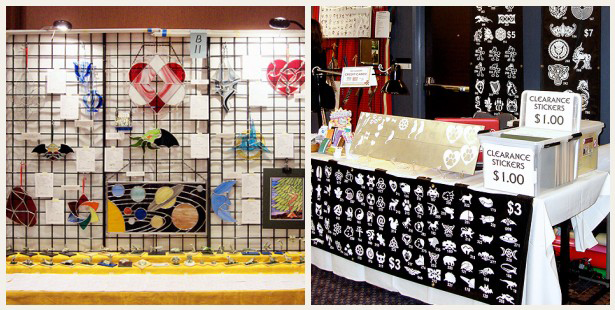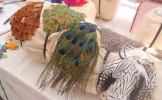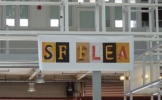Posted by Darlene Ostrowski
Thanks to my partner, a Star Trek and Doctor Who fan, I’ve known for years that sci fi conventions existed. But I never considered selling my handmade work at a sci fi con. I mean, they were just crowds of geeks in scarily accurate costumes who speak Klingon and never left their parents’ basement, right?
Wrong! Soon after I opened shop, I met Deb Kosiba, a veteran con-goer who’s sold at sci fi conventions and fandom events for years. She clued me in that a sci fi con offers great opportunities for alternative artists. At first, I wasn’t sure, but now that I have three cons under my belt, I’ve found she is correct!

Deb Kosiba has been selling her art at sci fi conventions for more than 20 years. (Photo courtesy of Deb Kosiba)
Deb talked with IndieMade about how to sell art at sci fi conventions:
When and how did you start selling your art at sci fi conventions?
Almost immediately after I started going to conventions, some twenty-mumble years ago. I saw that conventions had an art show, where you could sell art. I was an artist, with art to sell. I’ve been showing at conventions ever since. If I’m going to a convention, I’ll show something, since I’ll be there anyhow. Over the years I’ve shown illustrations, needlework, metalwork, vinyl stickers, jewelry, and most recently, stained glass.
How is selling at sci fi conventions different from selling at craft fairs?
The biggest advantage is a specialized audience. You can go in selling exactly what they are looking for. The biggest disadvantage is that the audience is fairly small. An average convention has 500–2,000 people.
At conventions, you’re selling to an extended family. If you don’t know a customer, you know several people who do. You definitely have to build a relationship with your customers.
Also, it’s more about long-range sales over the impulse buy. Most attendees know what they plan to buy ahead of time. They’ve probably been saving for it for months. They might really like your thing, but they won’t jeopardize their ability to buy that other thing they’re planning to buy. However, if they really like your thing, there’s a good chance that they’ll buy it in the future.
What are the ways artists can sell their work at a sci fi con?

Left: At a sci fi con art show, art is usually hung on gridwall or placed on tables, with bid sheets attached, and the artist doesn't need to be present. Right: A convention dealer's room has a more traditional, craft-show-like setup, with tables and sometimes wall space. (Photos courtesy of Deb Kosiba)
These are generalities; every convention is different.
Art Show – Art is hung on panels or displayed on tables. The fee to display art is around $1 per piece or $10 per panel. The show takes 10%-15% of each sale. It’s in a traffic-controlled room and guarded overnight. Art is sold by a silent bidding process on bid sheets. If the piece gets two to four bids, then it goes to the live auction, usually Saturday night.
Dealer’s Room – This is closest to a craft fair. You pay for table space and sell from your table all weekend.
Artist’s Alley – Dealer’s Room “Lite” for artists. It’s usually free and often first come first served, or there’s a random drawing for spots. There are strict limitations on what you can sell, because it is intended to be only for artists selling their art.
Who should consider selling at sci fi conventions? Does the art have to be related to fandom?
Yes, it has to be related to fandom. But “related” can be interpreted broadly—fantasy, science fiction, historical reenactment, goth, steampunk, renaissance, Japanese, wildlife conservation, 1950’s Retro Modern, spiritual, Celtic, Art Nouveau, tiki, Art Deco, or cats. Anything with cats.
How can artists and crafters find a sci fi con if they're not involved in the scene?
Visit this list of conventions, pick one, and go.
If you want to visit a convention first, you can “ghost” it for free. But you can’t go into any of the areas that require a badge. You can wander the public areas and get a feel for the convention.
The next level is a day badge, usually cheaper than a full membership. You can go into “badged” areas, like the dealer’s room or art show, for one day.
What can a newbie expect when selling at his or her first con?
It can be overwhelming; there’s so much going on. Bring a partner so you can take turns exploring the convention.
To customers, you’re not just some stranger, you’re someone they know. Because of this, they treat you and your art with far more respect. The customers tend to have longer conversations with you. You get to learn about their lives, families, and jobs.
The great part is that at the next convention, you’ll talk again with the same people. You can see it means a lot when you ask for an update on what they told you at the last convention. They can tell you’re not just there to sell them stuff they don't need. You’re their friend, and you listen to them, and nothing builds customer loyalty more than that.
Deb will be showing her work next at Anthrocon, June 14–17 in Pittsburgh.




